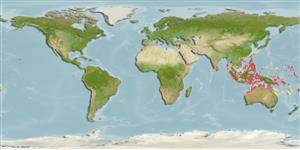>
Blenniiformes (Blennies) >
Tripterygiidae (Triplefin blennies) > Tripterygiinae
Etymology: Helcogramma: Greek, helkos, -eos, -ous = ulcer, sore + Greek, gramma = letter, mark (Ref. 45335).
Environment: milieu / climate zone / depth range / distribution range
Ökologie
seewasser riff-verbunden; tiefenbereich 0 - 12 m (Ref. 90102), usually 3 - 10 m (Ref. 13227). Tropical
Western Pacific: Philippines, Indonesia, New Guinea, Vanuatu, Australia, and the Solomon Islands.
Size / Gewicht / Alter
Maturity: Lm ? range ? - ? cm
Max length : 3.4 cm SL Männchen/unbestimmt; (Ref. 13227)
Rückenflossenstacheln (insgesamt) : 14 - 17; Rückenflossenweichstrahlen (insgesamt) : 8 - 12; Afterflossenstacheln: 1; Afterflossenweichstrahlen: 18 - 22. Dorsal fin III + XI-XIV (usually XII), 8-12 (usually 11); anal fin I, 18-22 (usually 19); pectoral rays 17, ventral most 6-7 simple and thickened, dorsalmost ray simple, remainder branched; pelvic fin I,2, spines simple and embedded, rays simple and bound together with membrane. Lateral line continuous, pored scales 12-18 (usually 14), terminates under 7th-10th dorsal-fin elements; head, nape and narrow strip on upper back scaleless. Mandibular sensory pores 5-12 + 5-10 + 5-12 (usually 3 + 1- 2 + 3); nasal tentacle small and leaf-like; orbital cirri absent; cephalic sensory pores simple, dorsally and laterally not covered by bone (Ref. 6211, 90102). Overall transluscent grey; body vertical bars, six, reddish brown, may be branched dorsally; pectoral fin spot red; caudal fin margin red. Male masked on ventral half of head; dorsal fins with bands; caudal fin margin black (Ref. 90102). Measurements in %SL: head length 33.9 (32.9-35.7); eye diameter 11.3 (10.4-12.7); second dorsal-fin base 33.6 (30.7-35.7); third dorsal fin base 22.0 (19.3-23.3); anal-fin base 44.5 (42.8-46.7); distance PI-anal fin 21.8 (18.9-24.5); first dorsal-fin spine 14.8 (12.2-17.4); longest second dorsal-fin spine 16.1 (14.4-17.1); longest third dorsal-fin segmented ray 15.0 (13.7-15.8); seventh pectoral-fin ray 29.3 (27.4-32.0); upper jaw length 15.9 (14.7-17.5); longest pelvic fin ray 24.4 (21.1-27.0) (Ref. 6211).
Adults live on rock surfaces and under ledges, commonly at depths less than 10 m (Ref. 13227). Eggs are hemispherical and covered with numerous sticky threads that anchor them in the algae on the nesting sites (Ref. 240). Larvae are planktonic which occur primarily in shallow, nearshore waters (Ref. 94114).
Life cycle and mating behavior
Maturities | Fortpflanzung | Spawnings | Egg(s) | Fecundities | Larven
Fricke, R., 1994. Tripterygiid fishes of Australia, New Zealand and the southwest Pacific Ocean (Teleostei). Theses Zool. 24:1-585. (Ref. 13227)
IUCN Rote Liste Status (Ref. 130435)
Bedrohung für Menschen
Harmless
Nutzung durch Menschen
Fischereien: nicht kommerziell
Tools
Zusatzinformationen
Download XML
Internet Quellen
Estimates based on models
Preferred temperature (Ref.
123201): 26.7 - 29.3, mean 28.7 °C (based on 1833 cells).
Phylogenetic diversity index (Ref.
82804): PD
50 = 0.5000 [Uniqueness, from 0.5 = low to 2.0 = high].
Bayesian length-weight: a=0.00562 (0.00258 - 0.01228), b=3.08 (2.89 - 3.27), in cm total length, based on LWR estimates for this (Sub)family-body shape (Ref.
93245).
Trophic level (Ref.
69278): 3.0 ±0.3 se; based on size and trophs of closest relatives
Widerstandsfähigkeit (Ref.
120179): hoch, Verdopplung der Population dauert weniger als 15 Monate. (Preliminary K or Fecundity.).
Fishing Vulnerability (Ref.
59153): Low vulnerability (10 of 100).
Nutrients (Ref.
124155): Calcium = 514 [190, 2,142] mg/100g; Iron = 2.76 [0.99, 6.44] mg/100g; Protein = 18 [16, 20] %; Omega3 = 0.0937 [, ] g/100g; Selenium = 56.8 [10.5, 256.4] μg/100g; VitaminA = 66.8 [9.7, 501.5] μg/100g; Zinc = 5.6 [2.4, 10.6] mg/100g (wet weight);
